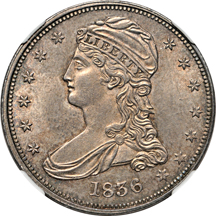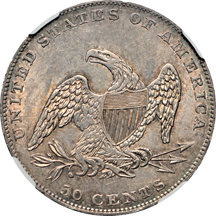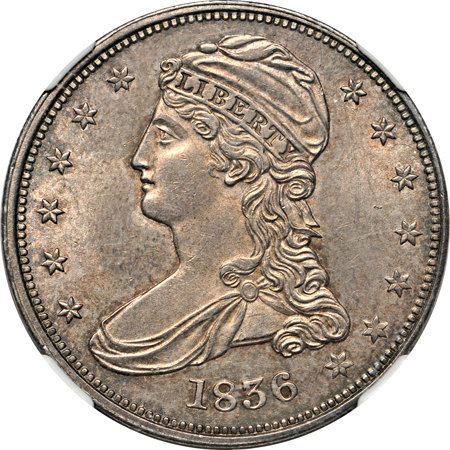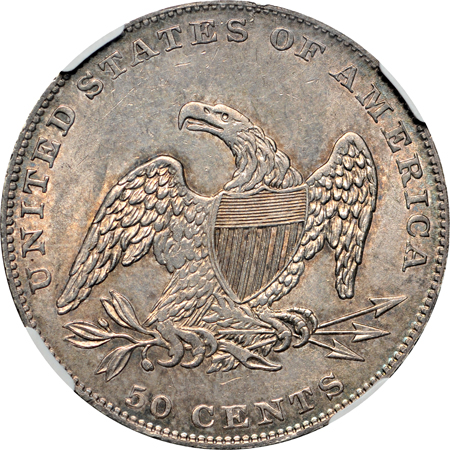The Collectors' Auction 2010
< Previous
Lot
484
Next >
| Choose Category: |
|
|
|
|
|
|
|
Please Note: A 15% Buyers' Premium is added to the hammer price of all lots in this sale.
|
(About The Images)


|
|
Lot Title:
|
1836 NGC MS-63.
|
|
Description:
|
The first U.S. coinage struck on the new steam press of 1836 and intended for circulation was the reeded-edge Capped Bust half-dollar, with 1200 believed to have been struck (some researchers suggest that about double that amount is the correct mintage). The purpose of the new technology was to bring high precision to the coining process, with the intent that coins be of uniform diameter and thickness to help deter counterfeiting. Prior to advent of the steam press, coins were struck from dies with an open collar and with unreliable organic power, and that allowed expansion of the planchet to occur at an unmanaged rate. Thus, lettered-edge half-dollars struck in 1836 and prior vary considerably in diameter and thickness. The new reeded-edge half-dollars promised consistency, and provided an opportunity to develop best practices for the new technology before other denominations came online. Still, uncirculated examples demonstrate some variation in terms of sharpness, and this example is not fully struck, likely made prior to subsequent optimization of striking pressure settings. As mentioned, details are not strictly complete for this coin, with softness noted in Liberty's hair above the ear, at the temple, and at the large uppermost fold in the cap. Likewise, the eagle displays distinct softness in the feathers where the left (observed) wing joins the shield, and his left talon is also indistinct. That being said, luster swirls gently through the fields, obscured to modest extent by generous platinum-grey patina with a faint hint of pinkish-mauve overtone. A number of brief, wispy hairlines cross over the cheek and most likely attest to long and proud placement in an album, the protective slide opened on numerous occasions to reveal the precious beauty within. One diagonal mark on the forehead, and a single pinpoint dig in the obverse right field left of the ninth star are the primary abrasions.
|
|
Low Estimate:
|
$14,000.00 |
|
High Estimate:
|
$16,000.00 |
|
Lot Status:
|
Bidding has been closed for this lot. |
|
Hammered Price: |
$14,000.00
|
|
Price Realized:
|
$16,100.00 |
|


Price history for items of the same classification:
| Lot # | Auction | Current Bid or Hammer Price | Description |
| 644 | The Midwest Summer Sale 2014 on 07/18/2014 | $2,400.00 |
|
1836 (GR-1) NGC XF-40.
|
|
Judd-57. The transition year between the old lettered-edge and new reeded-edge coins, any 1836 is treasured for its representation as the first half-dollar to be struck off the new steam-powered... |
|
| 570 | The Collectors' Auction 2012 on 10/05/2012 | $3,600.00 |
|
1836 NGC AU-53.
|
|
Aluminum-grey patina traverses virtually the entire coin and capitulates to a delicate, thin crescent of honey-tan at the upper and lower rim on both sides. One must look carefully to discern mint... |
|
| 419 | The Collectors' Auction 2009 on 10/16/2009 | $1,350.00 |
|
1836 VF details/reverse damage.
|
|
Dove-grey surfaces display excellent vintage quality and no signs of cleaning, with the few hairlines seen being incidental from circulation. What appears at first to be a planchet flaw cannot be... |
|
| 765 | The Midwest Summer Sale on 07/24/2009 | $1,700.00 |
|
1836 XF/cleaned/rim damage.
|
|
Undoubtedly the scarcest coin unearthed by the Merten brothers was this 1836 reeded edge half-dollar, inaugural issue of the type. Evidence of more than a century spent in the ground is indicated by... |
|
| 766 | The Midwest Summer Sale on 07/24/2009 | $2,500.00 |
|
1836 XF.
|
|
CONSIGNOR: These reeded edge 1836 coins are fascinating to me, rare, and most people probably wouldn't crack theirs out. It's funny how the mint was going with new technology, but they wanted to keep... |
|
| 767 | The Midwest Summer Sale on 07/24/2009 | $2,100.00 |
|
1836 AU/questionable color.
|
|
Although very little actual wear is apparent, slight rub can be seen on the usual hair curls above the ear, at the lower curls right of the clasp, and certainly on the eagle's beak and brow. However,... |
|
|